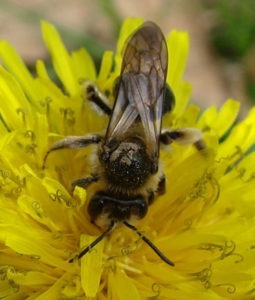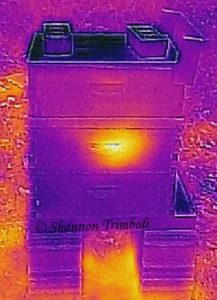Growing up in Kentucky, I commonly heard the phrase “If you don’t like the weather, wait 5 minutes and it will change.” As an adult, I learned that just about every state surrounding us has the same saying. The same thing is probably true for much of the rest of the eastern U.S. This is especially true in the winter months which are commonly interspersed with warmer days. Sometimes those “warmer days” can lead to a 30+ degree temperature swing over the course of just 24-48 hours.
On some of these warm, winter days, you might see bees or other insects out and about, which can lead to the question of what do bees do during the winter? The answer is, it depends. Honey bees do different things than bumble bees which do different things than ground nesting or stem nesting bees. Let’s take a few minutes to explore the different overwintering strategies of each.

Ground nesting, stem nesting, and wood nesting native bees
Most of our native bees nest in the ground, in wood, or in stems. These nests aren’t like a honey bee hive. Instead, with our ground nesting, stem nesting, and wood nesting native bees, all of the adults die off in the fall. Depending on the species, only the larva or pupa will survive the winter, and they do so in a state of paused development within their nesting chambers. Chemical changes within their bodies keep them from freezing.
The larva or pupa will stay in that state of paused development within their nesting chambers until the conditions are right to trigger their continued development and eventual emergence. Different species will emerge at different times and males typically emerge before females. While some species will emerge when it is still relatively cool (a late winter / early spring timeframe), it typically takes a relatively lengthy warm spell to meet the right conditions. One or two warm days usually isn’t enough.
Bumble bees
In the late summer and early fall, bumble bee colonies produce what will become next year’s queens. Each future queen will mate then find a rodent nest, abandoned burrow, clump of grass, or similar location to hibernate by herself. All the other bumble bees will die in the fall. Again, chemical changes in her body, keep the hibernating future queen from freezing during the winter. Once the temperatures warm up, the mated future queen will forage for nectar and pollen, find a place to establish her colony, begin laying eggs, and take care of the first round of brood.
Again, it’s typically going to take a string of warmer days to bring the bumble bee future queens out of hibernation. In other words, one or two 60-70 degree days surrounded by weeks of 40 degree days probably won’t do it. However, a week or two of 55-60 degree days might. (Those temperatures are just ballpark figures to give you an idea of what kinds of situations might trigger different responses. They aren’t meant as concrete temperatures that cause the bumble bees to do anything.)
Bumble bees can withstand cooler temperatures than most of our other native bees. Therefore, if the queen comes out of hibernation in the late winter or early spring, begins foraging, and then a cold spell sets in for a week or two, she will probably be ok. However, what happens if a queen does emerge too early from hibernation during a few warmer days before anything really starts to bloom?
Honestly, I’m not sure. I found some resources (mostly from the UK) that suggest they can go back into hibernation, while other resources suggest they can’t. Personally, as long as the red maples have started blooming, I don’t worry too much because I know that, although we might have another cold spell or two, there are still lots of nectar and pollen sources about to become available. And like I said, bumble bees are much more tolerant of colder weather than many other types of bees.
Honey bees
What honey bees do in the winter is different than all of our native bees. Honey bees overwinter as a colony with all, or virtually all, life stages present. In the fall, the queen will slow down or stop her egg laying, which has an obvious impact on the number of larva and brood present in the hive. Then sometime after the solstice as the days begin getting longer, the queen will begin laying again. Obviously, if the queen is laying eggs again, then the hive will also have larva and brood as the eggs hatch and the larva develop.
You can potentially find honey bees active on any warm (or sunny, warm-ish) day during the winter. The bees will come out of the hive to go to the bathroom, gather water to bring back to the hive, and search for any available nectar or pollen. Here in Kentucky, I see my honey bees out and about at least once during just about every month of the year.
Honey bees, unlike our native bees, don’t hibernate or go into a paused developmental state with chemical changes in their bodies to keep them from freezing during cold winter weather. Instead, honey bees must actively generate heat and keep themselves warm during cold winter days and nights. And yes, I’m talking about a cold-blooded insect generating heat.
Honey bees keep themselves warm, or more appropriately keep the colony warm, through clustering and shivering. All of the bees in the colony will form a big clump or cluster around the queen. The bees in the middle will then begin to vibrate, or shiver, their wing muscles which produces heat. (They aren’t flapping their wings, just vibrating the muscles in the same way that our arms aren’t flailing around when our shoulders are shivering.)

The middle of the cluster can be 90-95 degrees, even when the normal air temperature is below freezing. All of the other bees act as insulation to keep the central core of the cluster warm. As the bees on the outside get too cold, they move closer to the center. In some ways, this is kind of like penguins huddling up in Antarctica. The colder the outside temperature is, the tighter the bees huddle together. The warmer the outside temperature is, the looser the cluster of bees is.
One big difference between the honey bees and the penguins is that the honey bees don’t form one solid mass or ball of bees. Instead, the cluster of honey bees is dissected by the combs in the hive. The bees will actually stick their heads into the empty cells of the comb to help transfer heat to the bees on the other side of the comb. (It’s a common misconception that finding dead bees with their heads stuffed in empty cells of the comb indicates that the hive died from starvation. Instead, it usually means that they froze to death.)
It takes a lot of energy for a colony of honey bees to generate the heat needed to keep everyone warm during the cold winter months. During cold weather, the cluster must always be touching food in order to provide the energy needed to generate the necessary warmth. If it’s too cold, then none of the bees will be able to move away from the cluster to get more food. A single honey bee by herself can’t shiver enough to keep herself warm. She needs her sisters around her.
This inability to break cluster to get nearby food is why beekeepers sometimes find hives that died during the winter, but had plenty of honey only inches away from where the bees were clustered on the frames. This happens a lot during the late winter when temperatures are yo-yoing from warm to cold and back again. During the warmer weather, the bees may be loosely clustered and touching plenty of food. However, as the cluster constricts with the dropping temperature, the bees may no longer have access to the food that they were using during the warmer weather.
There are a few things that beekeepers can do to help their honey bees survive the winter, but even those are limited and heavily depend on the weather and the behavior of the bees. When it comes to native bees or feral honey bees, there really isn’t much we can do to help them survive the winter other than provide habitat for our native bees and make sure the honey bees and future bumble bee queens had plenty of floral resources in the fall. However, even though there isn’t much I can do, I still think it is interesting to know what’s happening behind the scenes and to understand the lives of honey bees and native bees in the winter.

Backyard Ecology: Exploring Nature in Your Backyard
Nature isn’t just “out there.” It’s all around us, including right outside our doors. Hi, my name is Shannon Trimboli, and I am the host of Backyard Ecology. I live in southcentral Kentucky and am a wildlife biologist, educator, author, beekeeper, and owner of a nursery specializing in plants for pollinators and wildlife conservation. I invite you to join me as we ignite our curiosity and natural wonder, explore our yards and communities, and improve our local pollinator and wildlife habitat. Learn more or subscribe to my email list at www.backyardecology.net.

Leave a Reply